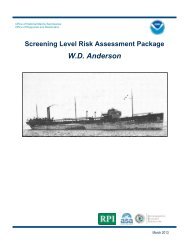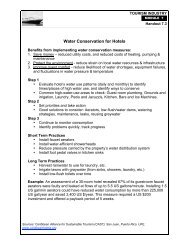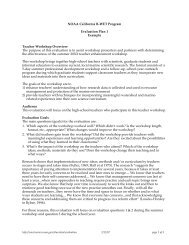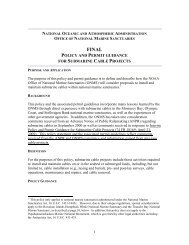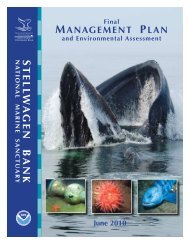The Impacts of Coastal Protection Structures in California's Monterey ...
The Impacts of Coastal Protection Structures in California's Monterey ...
The Impacts of Coastal Protection Structures in California's Monterey ...
- No tags were found...
You also want an ePaper? Increase the reach of your titles
YUMPU automatically turns print PDFs into web optimized ePapers that Google loves.
ENGINEERING OF COASTAL ARMORING STRUCTURESWith the exception <strong>of</strong> passive erosion, all <strong>of</strong> the impacts described above can be <strong>in</strong>fluencedby the design and type <strong>of</strong> armor<strong>in</strong>g used. Methods for construct<strong>in</strong>g and repair<strong>in</strong>g coastalprotection structures are not standardized and poor eng<strong>in</strong>eer<strong>in</strong>g can lead to failure and additionalcosts (USACE 1981; Griggs and Fulton-Bennett 1988; Chenault 2000). To be susta<strong>in</strong>able andeffective, armor<strong>in</strong>g must survive the follow<strong>in</strong>g forces: overtopp<strong>in</strong>g by large storm waves,underm<strong>in</strong><strong>in</strong>g by scour at the base, outflank<strong>in</strong>g by erosion on either side, and batter<strong>in</strong>g by waves,sediment and debris. <strong>The</strong> follow<strong>in</strong>g is a brief description <strong>of</strong> some <strong>of</strong> the eng<strong>in</strong>eer<strong>in</strong>gconsiderations <strong>in</strong> build<strong>in</strong>g riprap and seawalls.RiprapEng<strong>in</strong>eered riprap must have several elements to efficiently protect the coast, as outl<strong>in</strong>ed <strong>in</strong> astudy <strong>of</strong> the effectiveness <strong>of</strong> riprap <strong>in</strong> central California (Griggs and Fulton-Bennett 1988):• Excavation <strong>of</strong> sand, if built on the beach• Filter cloth at base• A trench at the seaward edge <strong>of</strong> structure (referred to as a “toe trench”) belowmaximum scour depth, with large stone (4-6 tons) <strong>in</strong> toe trench• Stable slope angles <strong>of</strong> at least 1.5:1 (width across the beach: height), 2:1 is moresuccessful• Small core stones placed down first on top <strong>of</strong> filter cloth• Large cap stone (3-5 tons) on top, positioned <strong>in</strong> an <strong>in</strong>terlock<strong>in</strong>g pattern• Height great enough to prevent overtopp<strong>in</strong>gIn addition to these eng<strong>in</strong>eer<strong>in</strong>g specifications, riprap generally requires regular ma<strong>in</strong>tenanceby add<strong>in</strong>g rocks every 5 to 10 years. <strong>The</strong>se structures can cost over $1500 per l<strong>in</strong>ear foot (<strong>in</strong>2003 dollars), with annual ma<strong>in</strong>tenance costs <strong>of</strong> 2-15% <strong>of</strong> the <strong>in</strong>itial cost. Riprap that is built ontop <strong>of</strong> bedrock platforms generally lasts longer than those placed on beaches, because asignificant amount <strong>of</strong> settl<strong>in</strong>g and burial can occur <strong>in</strong> active beach environments (Figure 9).13



